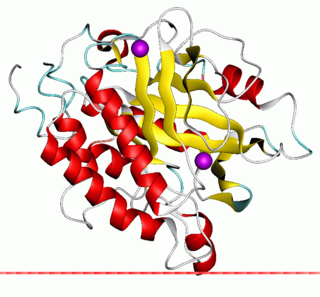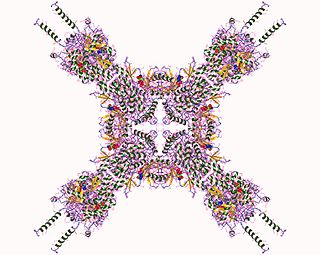
Phosphatidylinositol consists of a family of lipids made of a phosphate group, two fatty acid chains, and one inositol molecule. They represent a class of the phosphatidylglycerides. Typically phosphatidylinositols form a minor component on the cytosolic side of eukaryotic cell membranes. The phosphate group gives the molecules a negative charge at physiological pH.

Phosphoinositide phospholipase C is a family of eukaryotic intracellular enzymes that play an important role in signal transduction processes. These enzymes belong to a larger superfamily of Phospholipase C. Other families of phospholipase C enzymes have been identified in bacteria and trypanosomes. Phospholipases C are phosphodiesterases.

The enzyme phosphatidylinositol diacylglycerol-lyase catalyzes the following reaction:
The enzyme inositol-1,4-bisphosphate 1-phosphatase (EC 3.1.3.57) catalyzes the reaction
The enzyme phosphatidylinositol-3,4-bisphosphate 4-phosphatase (EC 3.1.3.66) that catalyzes the reaction
The enzyme phosphatidylinositol-3-phosphatase (EC 3.1.3.64) catalyzes the reaction
The enzyme phosphoinositide 5-phosphatase (EC 3.1.3.36) catalyzes the reaction
In enzymology, a 1-phosphatidylinositol-3-phosphate 5-kinase is an enzyme that catalyzes the chemical reaction

In enzymology, a 1-phosphatidylinositol 4-kinase is an enzyme that catalyzes the chemical reaction
In enzymology, 1-phosphatidylinositol-4-phosphate 5-kinase is an enzyme that catalyzes the chemical reaction
In enzymology, a 1-phosphatidylinositol-5-phosphate 4-kinase is an enzyme that catalyzes the chemical reaction

In enzymology, a CDP-diacylglycerol—inositol 3-phosphatidyltransferase is an enzyme that catalyzes the chemical reaction
In enzymology, a diphosphoinositol-pentakisphosphate kinase is an enzyme that catalyzes the chemical reaction
In enzymology, an inositol 3-kinase is an enzyme that catalyzes the chemical reaction
In enzymology, an inositol-pentakisphosphate 2-kinase is an enzyme that catalyzes the chemical reaction
In enzymology, an inositol-tetrakisphosphate 1-kinase is an enzyme that catalyzes the chemical reaction
In enzymology, an inositol-tetrakisphosphate 5-kinase is an enzyme that catalyzes the chemical reaction
In enzymology, a phosphatidylinositol-4,5-bisphosphate 3-kinase is an enzyme that catalyzes the chemical reaction:
Bisphosphate may refer to:
Phosphatidylinositol-3,4,5-trisphosphate 5-phosphatase is an enzyme with systematic name 1-phosphatidyl-1D-myo-inositol-3,4,5-trisphosphate 5-phosphohydrolase, that has two isoforms: SHIP1 and SHIP2 (INPPL1).





